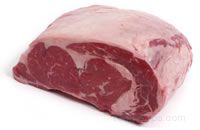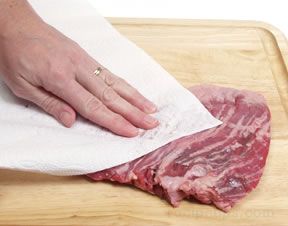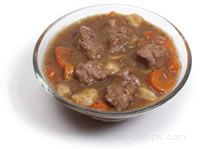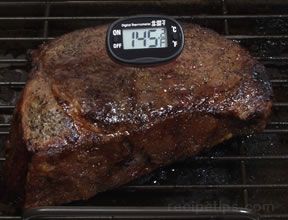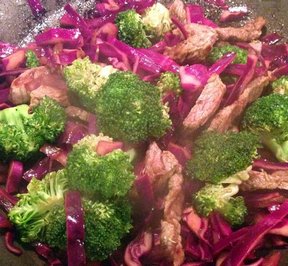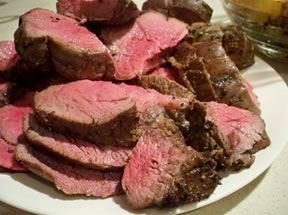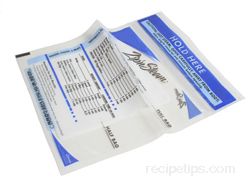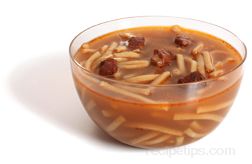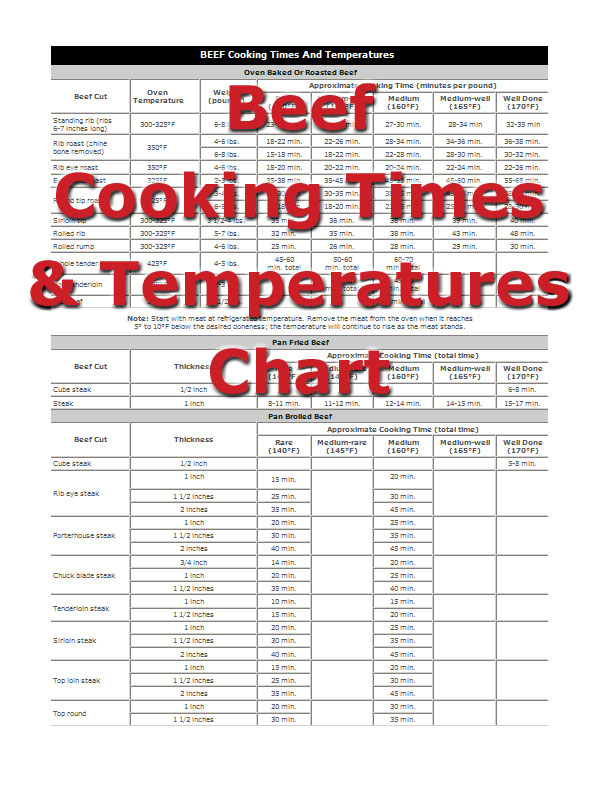General Guidelines | Charcoal Grill | Gas Grill | Doneness
|
Rotisserie cooking requires three key components: The spit assembly, a means to turn the spit, and a heat source for cooking. The spit refers to a device consisting of one or more metal bars onto which meat or other foods are skewered. There are two types of spits that are used most often. The first one is a long skewer that is pushed through the food. The skewer may resemble a heavy round bar depending on the size of the rotisserie unit and the total weight that must be supported. After the meat has been skewered, two prongs (or "forks") are attached to each side of the meat to hold it in place. The spit, or skewer, is placed on brackets that allow the food to be suspended above, or in front of, a heat source. A second type of spit is a split rod assembly in which two narrow skewers are pushed through the food and are attached to gears on both ends of the rotisserie unit. Because two skewers are used, there is no need for the use of additional hardware (such as the fork attachments used with the single skewer assembly) to prevent the meat from slipping on the skewers while rotating. With the use of a mechanical or manual device, the spit slowly rotates at a consistent speed. The constant rotation of the rotisserie allows meat to cook evenly. The juices within the meat are distributed equally resulting in tender, self basted meat. The meat develops a smoked flavor and a perfect crispy crust. Modern rotisseries are equipped with an electric motor, which allows for even rotation of the food. The first rotisseries were crude devices that allowed for food to be rotated manually while it cooked over an open fire. Before electric motors were specifically built for rotisseries, almost any method imaginable was used to power the rotisserie, although a hand crank was most commonly used. Manually operated rotisseries are still occasionally used in fireplaces and over open outdoor fires. Examples of Motorized Rotisseries
Rotisseries are built in a variety of sizes ranging from models able to accommodate a small chicken to large models used for roasting very large primal cuts of meat or whole animals such as a lamb or pig. Some rotisseries are built as attachments for outdoor charcoal grills and many outdoor gas grills are equipped with rotisseries as a standard feature. There are also a variety of indoor electric countertop rotisseries, which consist of a self contained oven-like cabinet with a heating element in the back. The food roasts as it rotates on a spit in front of the heat source. The units come with temperature controls, timers, and a drip pan for collecting any melting fat. Before cooking with a rotisserie, it is important to read the instruction manual included with the rotisserie. Make sure that the unit is used correctly and that safely instructions are always followed. If the rotisserie unit will be used with a charcoal or gas grill, it is important that the rotisserie is designed specifically for the particular grill that is being used as the heat source. |
General Guidelines for Rotisserie Cooking of Beef
|
There are two methods of cooking beef using a rotisserie: direct heat cooking and indirect heat cooking. The method that is used is dependent upon how the rotisserie is positioned in relation to the heat source. Placing the meat over the heat source is direct heat cooking and results in beef with a grilled quality. This works best for small cuts of beef, but direct cooking is rarely used in conjunction with rotisserie cooking. Indirect cooking is most often used because it allows the meat to cook slowly and evenly, which is the primary purpose for using a rotisserie for cooking. The rotisserie is positioned in front of or next to the heat source, which works extremely well for larger cuts of beef. The indirect heat will allow the interior portions of the meat to cook thoroughly before the exterior becomes overdone. When setting up for rotisserie cooking using a charcoal or gas grill as the heat source, the grills must be preheated before rotisserie cooking can begin. (Refer to the article, "Grilling Beef" for details on preheating.) The best results are achieved when beef cuts are seared at a high temperature for the first few minutes, followed by low to medium/low heat for the remainder of the cooking time. A rotisserie ring is beneficial when using a charcoal grill because it allows the spit to be positioned at the perfect height in relation to the heat source. Examples of Beef Cuts Suited for Rotisserie Cooking
Cooking beef with a rotisserie is most successful when cooking beef cuts that have a basic cylindrical shape. Oven roasts, such as a tenderloin roast (pictured above left) or a rolled boneless rib roast (pictured above right), are excellent candidates for rotisserie cooking. Rib-eye roasts and top loin roasts are equally good choices. Tender cuts that are flat or irregularly shaped may be used if they are boned, rolled, and tied. A rotisserie basket (shown below), can also be used for cooking flat pieces of beef, which allows the meat to be cooked on the rotisserie without having to be directly skewered. Rotisserie Basket
Market ready cuts from the round and chuck are usually not suitable for cooking with a rotisserie because they are tougher and lack the marbling that is important for keeping the meat tender while cooking. However, they can be quite flavorful and acceptably tender if they are not overcooked and if they are marinated for several hours prior to cooking. Beef can be cooked on a rotisserie using numerous recipes. Most of the recipes can be used for grilling, broiling, or roasting if the cooking time is adjusted accordingly. High quality meat usually does not require too many additional flavorings, so a particular recipe may not be necessary. A coating of olive oil, salt, and pepper may be all that is necessary or a rub of fresh herbs may be used to create a flavorful crust on the exterior. |
Rotisserie Cooking with a Charcoal Grill
| When rotisserie cooking on a charcoal grill using indirect heat, the fire is built on the side of the kettle or in a ring around the perimeter, away from the location where the food is to be positioned. The meat is cooked by radiant heat rather than direct heat (as if in an oven). None of the hot coals should be directly under the meat. A drip pan is placed under the meat (a disposable aluminum pan works well) to catch the melted fat that drips from the meat as it cooks. Due to the extended cooking time, fresh charcoal must be added every 30-40 minutes to maintain the proper cooking temperature. |  |
| The following steps may be used for rotisserie setup on a charcoal grill: |
|
Rotisserie Cooking with a Gas Grill
| The best gas grills for use in rotisserie cooking are models with front and back burners or models that have three burners arranged in a line front to back. The burners should be ignited to allow the grill to preheat before the meat is placed on the rotisserie. When the grill has preheated, all of the burners except for the rear burner are shut off. The spit is positioned over the front or center burner so that the food is not directly over the heat source (the rear burner). If the grill has only two side-by-side burners, set both of the burners on low. When a drip pan is placed on the grate, the meat will be shielded by much of the direct heat of the burners. | 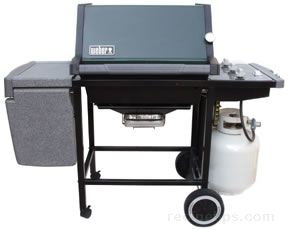 |
| The following steps may be used for rotisserie setup on a gas grill: |
|
|
| ||
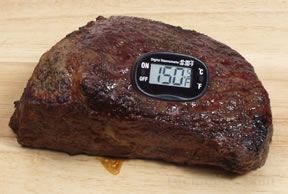 |
The minimum temperature recommended for cooking most beef cuts is 140ºF. (During the resting period, the temperature of the meat will rise an additional 5ºF or so, reaching the minimum recommended safe temperature of 145ºF). Any boneless beef roast that contains stuffing and is then rolled and tied should be cooked to a minimum temperature of 160ºF. (During the resting period, the temperature of the meat will rise an additional 5ºF or so). | |
| It is also easy to visually determine when the beef is thoroughly cooked. The exterior of the beef will appear crispy with a dark brown color and the meat will begin to split apart. The visual signs of proper doneness should be used only as a guide (especially when cooking a roast with stuffing). Using a meat thermometer is the only sure method to verify the correct doneness of the meat. | ||






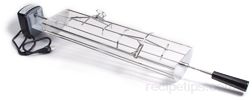

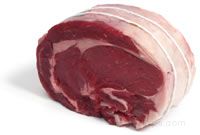

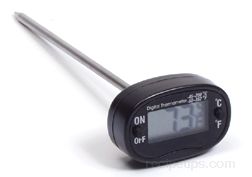 Rather than relying on a cooking time chart for proper doneness, always use a meat thermometer. The chart does not allow for the many variables that often influence doneness. A cooking time chart should be used as a guide only and should not be used as a substitute for the accuracy of a good meat thermometer. To accurately check temperature, the thermometer must be pushed through the thickest part of the meat and away from any bones (bones conduct heat).
Rather than relying on a cooking time chart for proper doneness, always use a meat thermometer. The chart does not allow for the many variables that often influence doneness. A cooking time chart should be used as a guide only and should not be used as a substitute for the accuracy of a good meat thermometer. To accurately check temperature, the thermometer must be pushed through the thickest part of the meat and away from any bones (bones conduct heat).


